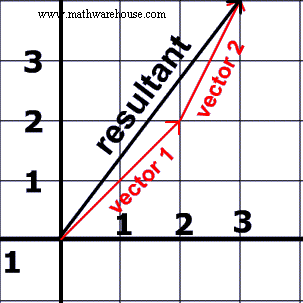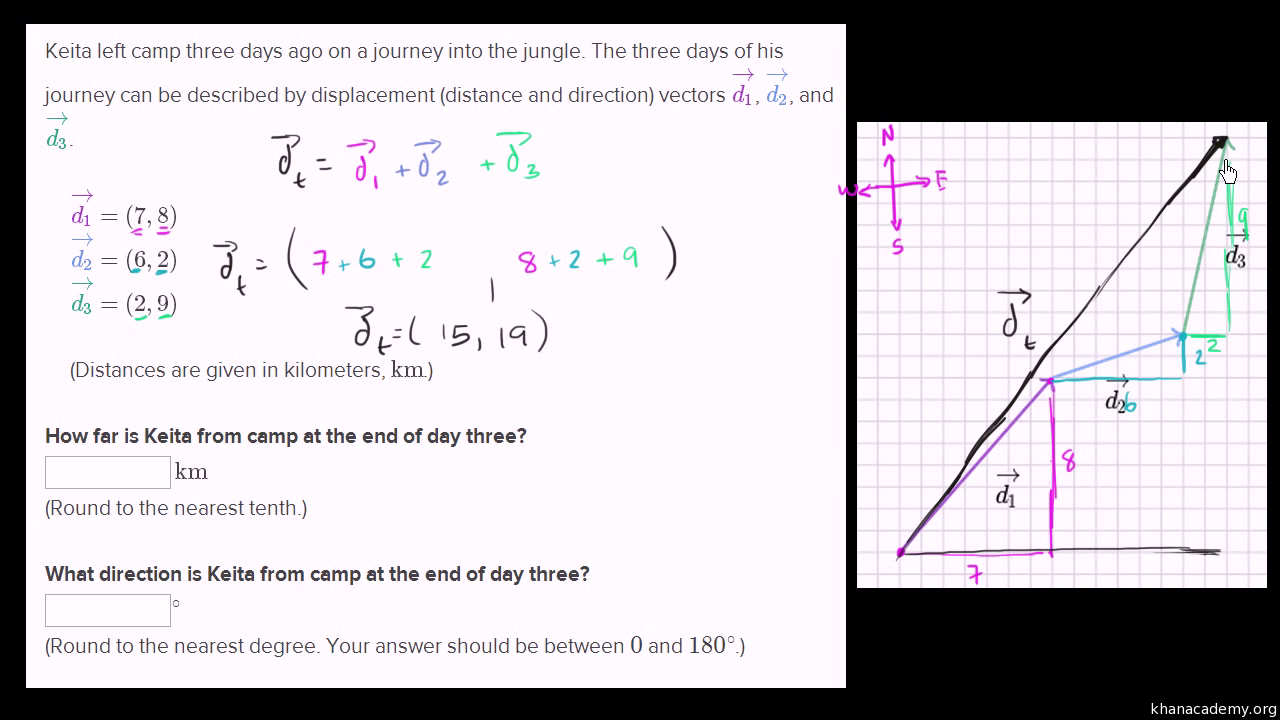How To Find The Resultant Displacement
How to find resultant displacement R. Ive been going at it for about 2 hours coming close but not quite there.

Vector Addition And Subtraction Analytical Methods Physics
There are a two different ways to calculate the resultant vector.

How to find the resultant displacement. And then 30 m due east. Displacement is defined as the change in position of an object. Add your answer and earn points.
In this example the ratio of the displacement components is 155 and calculating the inverse tangent of this number gives 716 degrees. How do you use the graphical method to solve the resultant vector. In this example the ratio of the displacement components is 155 and calculating the inverse tangent of this number gives 716 degrees.
About Press Copyright Contact us Creators Advertise Developers Terms Privacy Policy Safety How YouTube works Test new features Press Copyright Contact us Creators. G The three displacement vectors in the drawing have magnitudes of A 555 m B 657 m and C 450 m. The magnitude and direction of R are.
Therefore the resultant displacement is 158 units with a direction of 716 degrees from the original. Here P and Q are two vectors which are perpendicular to each other. The graphical method of adding vectors A and B involves drawing vectors on a graph and adding them using the head-to-tail method.
When an object is subject to several forces the resultant force is the force that alone produces the same acceleration as all those forces. The resultant force is described as the total amount of force acting on the object or body along with the direction of the body. 3 on a question.
From the vector principle when two vectors are perpendicular to each other then. - 7073682 trishinada63 is waiting for your help. The resultant vector R is defined such that A B R.
The resultant of two vectors is given by R P 2 Q 2. Let Q 30 m. Methods for calculating a Resultant Vector.
Vectors A and B are two legs of a walk and R is the resultant or total displacement. If the direction travels in one direction then y is 0. 5 Determine the net displacement of a particle or the location of a particle relative to another.
How to Find Resultant Displacement in Physics. The resultant vector is the vector that results from adding two or more vectors together. An example is shown of adding three.
This gives the components of R. Home how to find the resultant displacement of 4 vectors Home how to find the resultant displacement of 4 vectors. To find the direction of the displacement vector calculate the inverse tangent of the ratio of the displacement components in the y- and x-directions.
The resultant force should be equal. To find the resultant displacement in a physics problem apply the Pythagorean formula to the distance equation and use trigonometry to find the direction of movement. It is a vector quantity as it has both direction and magnitude.
The head to tail method to calculate a resultant which involves. For example if 4 forces act on a block and cause it to accelerate 1 ms 2 south then the resultant force is the force that if applied. Therefore the resultant displacement is 158 units with a direction of 716 degrees from the original.
4 How do you find the displacement. First displacement of 30 due south and then 30 m due east. An objects displacement is based on its initial location and its final location during its motion.
An example is shown of adding three force vectors using the component me. The magnitude of R is. It is given first displacement is 30 m due south.
6 What is a negative vector. Let P 30 m. Use horizontal and vertical components to find the resultant of two or more vectors.
Formula to calculate displacement. Find the resultant a magnitude and b. 5 What is the meaning of resultant force.
How to Find Resultant Displacement in Physics. An object can only travel in two directions maximum. Physics Math - YouTube.
Accordingly we may wonder what is resultant force Class 8. To find the direction of the displacement vector calculate the inverse tangent of the ratio of the displacement components in the y- and x-directions. Resultant 5 cos 3 7 0 i 5 sin 3 7 0 j 6 i 4 j 1 0 i 7 j Thus magnitude 1 0 0 4 9 1 4 9.

Vector Addition Example Resultant Displacement Youtube
Resultant As Magnitude And Direction Ck 12 Foundation
46 The Three Displacement Vectors In The Drawing Have Magnitudes Of A 5 00 M B 5 00 M And C 4 00 M Find The Resultant Magnitude And Directional Angle Of The Three Vectors By Means Of The Component Method Express The Directional Angle As An

5 2 Vector Addition And Subtraction Analytical Methods Texas Gateway

5 1 Vector Addition And Subtraction Graphical Methods Texas Gateway

Question Video Identifying The Resultant Of Two Interfering Waves Nagwa

Resultant Vector How To Calculate A Resultant Using The Parallelogram Method And The Head To Tail Method A Resultant Is Simply

Determine Resultant Of Two Vectors Using Pythagorean Theorem Solved Problems In Basic Physics

Vector Word Problem Hiking Video Khan Academy

Vector Addition And Subtraction Graphical Methods Physics

Calculating Resultant Forces Vector Diagrams Graphs Work Done Calculations Equilibrium Parallelogram Of Forces Tension Vector Forces Gcse 9 1 Physics Igcse Revision Notes

Vector Addition Example Resultant Displacement Youtube

Vector Addition And Subtraction Analytical Methods Physics

Resultant Displacement Problems Youtube

Resultant Displacement Problems Youtube

Determine Resultant Of Two Vectors Using Pythagorean Theorem Solved Problems In Basic Physics

How To Find A Displacement Vector Video Lesson Transcript Study Com


Post a Comment for "How To Find The Resultant Displacement"